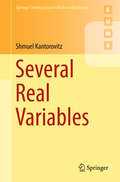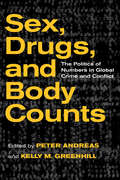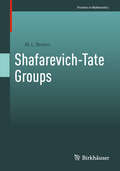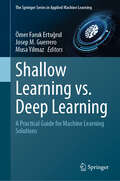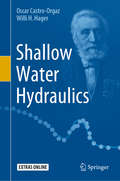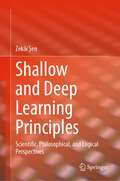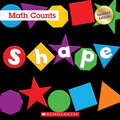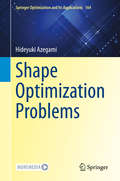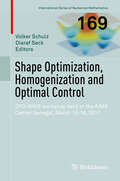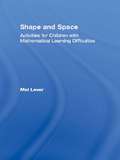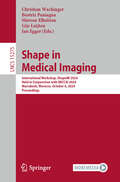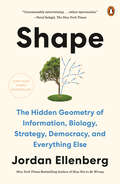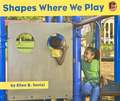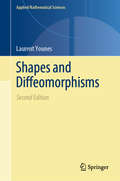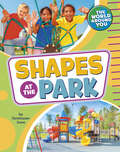- Table View
- List View
Several Complex Variables and the Geometry of Real Hypersurfaces
by John P. D'AngeloSeveral Complex Variables and the Geometry of Real Hypersurfaces covers a wide range of information from basic facts about holomorphic functions of several complex variables through deep results such as subelliptic estimates for the ?-Neumann problem on pseudoconvex domains with a real analytic boundary. The book focuses on describing the geometry of a real hypersurface in a complex vector space by understanding its relationship with ambient complex analytic varieties. You will learn how to decide whether a real hypersurface contains complex varieties, how closely such varieties can contact the hypersurface, and why it's important. The book concludes with two sets of problems: routine problems and difficult problems (many of which are unsolved). Principal prerequisites for using this book include a thorough understanding of advanced calculus and standard knowledge of complex analysis in one variable. Several Complex Variables and the Geometry of Real Hypersurfaces will be a useful text for advanced graduate students and professionals working in complex analysis.
Several Real Variables
by Shmuel KantorovitzThis undergraduate textbook is based on lectures given bythe author on the differential and integral calculus of functions of severalreal variables. The book has a modern approach and includes topics such as: *The p-norms on vector space and theirequivalence *The Weierstrass and Stone-Weierstrassapproximation theorems *The differential as a linear functional;Jacobians, Hessians, and Taylor's theorem in several variables *The Implicit Function Theorem for a system ofequations, proved via Banach's Fixed Point Theorem *Applications to Ordinary Differential Equations *Line integrals and an introduction to surfaceintegrals This book features numerous examples, detailed proofs, aswell as exercises at the end of sections. Many of the exercises have detailedsolutions, making the book suitable for self-study. Several Real Variables will be useful for undergraduatestudents in mathematics who have completed first courses in linear algebra andanalysis of one real variable.
Severe Storms: Anatomy, Early Warning Systems and Aftermath in Changing Climate Scenarios
by Wei-Kuo Tao Someshwar DasThe book provides information on the observational aspects of the severe storms through satellite, radar, aircraft, and ground based network of stations and these issues are discussed in the first part of the book consisting of 8 chapters. The numerical modelling and data assimilation techniques are discussed in the second part of the book aimed at development of Early Warning Systems (12 chapters) and finally the outlook of the severe storms in a changing climate scenario, their socio-economic impacts and policies for disaster mitigation are discussed in the third part of the book consisting of 6 chapters. This book is of great interest to atmospheric scientists and other researchers, practitioners, policy and decision makers, international institutions, governmental and non-governmental organizations, educators, as well as students.
Sex, Drugs, and Body Counts: The Politics of Numbers in Global Crime and Conflict
by Peter Andreas Kelly M. GreenhillAt least 200,000-250,000 people died in the war in Bosnia. "There are three million child soldiers in Africa." "More than 650,000 civilians have been killed as a result of the U.S. occupation of Iraq." "Between 600,000 and 800,000 women are trafficked across borders every year." "Money laundering represents as much as 10 percent of global GDP." "Internet child porn is a $20 billion-a-year industry." These are big, attention-grabbing numbers, frequently used in policy debates and media reporting. Peter Andreas and Kelly M. Greenhill see only one problem: these numbers are probably false. Their continued use and abuse reflect a much larger and troubling pattern: policymakers and the media naively or deliberately accept highly politicized and questionable statistical claims about activities that are extremely difficult to measure. As a result, we too often become trapped by these mythical numbers, with perverse and counterproductive consequences.This problem exists in myriad policy realms. But it is particularly pronounced in statistics related to the politically charged realms of global crime and conflict-numbers of people killed in massacres and during genocides, the size of refugee flows, the magnitude of the illicit global trade in drugs and human beings, and so on. In Sex, Drugs, and Body Counts, political scientists, anthropologists, sociologists, and policy analysts critically examine the murky origins of some of these statistics and trace their remarkable proliferation. They also assess the standard metrics used to evaluate policy effectiveness in combating problems such as terrorist financing, sex trafficking, and the drug trade.
Shadow Algorithms Data Miner
by Andrew Woo Pierre PoulinShadow Algorithms Data Miner provides a high-level understanding of the complete set of shadow concepts and algorithms, addressing their usefulness from a larger graphics system perspective. It discusses the applicability and limitations of all the direct illumination approaches for shadow generation.With an emphasis on shadow fundamentals, the boo
Shafarevich-Tate Groups (Frontiers in Mathematics)
by M.L. BrownThis monograph explores the finiteness and structure of Shafarevich-Tate groups of abelian varieties over global fields of any characteristic. Readers will better understand how the methods of Euler systems and Kolyvagin systems can be adapted to Heegner points and CM points. Also offered is a comprehensive overview of the most important classical and recent results on these objects. Shafarevich-Tate Groups will be a valuable resource to those interested in this active area of research.
Shallow Learning vs. Deep Learning: A Practical Guide for Machine Learning Solutions (The Springer Series in Applied Machine Learning)
by Josep M. Guerrero Ömer Faruk Ertuğrul Musa YilmazThis book explores the ongoing debate between shallow and deep learning in the field of machine learning. It provides a comprehensive survey of machine learning methods, from shallow learning to deep learning, and examines their applications across various domains. Shallow Learning vs Deep Learning: A Practical Guide for Machine Learning Solutions emphasizes that the choice of a machine learning approach should be informed by the specific characteristics of the dataset, the operational environment, and the unique requirements of each application, rather than being influenced by prevailing trends. In each chapter, the book delves into different application areas, such as engineering, real-world scenarios, social applications, image processing, biomedical applications, anomaly detection, natural language processing, speech recognition, recommendation systems, autonomous systems, and smart grid applications. By comparing and contrasting the effectiveness of shallow and deep learning in these areas, the book provides a framework for thoughtful selection and application of machine learning strategies. This guide is designed for researchers, practitioners, and students who seek to deepen their understanding of when and how to apply different machine learning techniques effectively. Through comparative studies and detailed analyses, readers will gain valuable insights to make informed decisions in their respective fields.
Shallow Water Hydraulics
by Willi H. Hager Oscar Castro-OrgazThis book presents the theory and computation of open channel flows, using detailed analytical, numerical and experimental results. The fundamental equations of open channel flows are derived by means of a rigorous vertical integration of the RANS equations for turbulent flow. In turn, the hydrostatic pressure hypothesis, which forms the core of many shallow water hydraulic models, is scrutinized by analyzing its underlying assumptions. The book’s main focus is on one-dimensional models, including detailed treatments of unsteady and steady flows. The use of modern shock capturing finite difference and finite volume methods is described in detail, and the quality of solutions is carefully assessed on the basis of analytical and experimental results.The book’s unique features include:• Rigorous derivation of the hydrostatic-based shallow water hydraulic models• Detailed treatment of steady open channel flows, including the computation of transcritical flow profiles• General analysis of gate maneuvers as the solution of a Riemann problem• Presents modern shock capturing finite volume methods for the computation of unsteady free surface flows• Introduces readers to movable bed and sediment transport in shallow water models• Includes numerical solutions of shallow water hydraulic models for non-hydrostatic steady and unsteady free surface flowsThis book is suitable for both undergraduate and graduate level students, given that the theory and numerical methods are progressively introduced starting with the basics. As supporting material, a collection of source codes written in Visual Basic and inserted as macros in Microsoft Excel® is available. The theory is implemented step-by-step in the codes, and the resulting programs are used throughout the book to produce the respective solutions.
Shallow and Deep Learning Principles: Scientific, Philosophical, and Logical Perspectives
by Zekâi ŞenThis book discusses Artificial Neural Networks (ANN) and their ability to predict outcomes using deep and shallow learning principles. The author first describes ANN implementation, consisting of at least three layers that must be established together with cells, one of which is input, the other is output, and the third is a hidden (intermediate) layer. For this, the author states, it is necessary to develop an architecture that will not model mathematical rules but only the action and response variables that control the event and the reactions that may occur within it. The book explains the reasons and necessity of each ANN model, considering the similarity to the previous methods and the philosophical - logical rules.
Shape (Math Counts: Updated Editions)
by Henry PluckroseAn introduction to capacity for the youngest readers!Math Counts series introduces young readers (grades K-3) to early math concepts. Real-world examples and corresponding photos make math concepts easy to grasp.Squares, triangles, circles... Shapes are all around us.
Shape Optimization And Optimal Design
by John Cagnol Michael P. Polis Jean-Paul ZolésioThis volume presents developments and advances in modelling passive and active control systems governed by partial differential equations. It emphasizes shape analysis, optimal shape design, controllability, nonlinear boundary control, and stabilization. The authors include essential data on exact boundary controllability of thermoelastic plates with variable transmission coefficients.
Shape Optimization Problems (Springer Optimization and Its Applications #164)
by Hideyuki AzegamiThis book provides theories on non-parametric shape optimization problems, systematically keeping in mind readers with an engineering background. Non-parametric shape optimization problems are defined as problems of finding the shapes of domains in which boundary value problems of partial differential equations are defined. In these problems, optimum shapes are obtained from an arbitrary form without any geometrical parameters previously assigned. In particular, problems in which the optimum shape is sought by making a hole in domain are called topology optimization problems. Moreover, a problem in which the optimum shape is obtained based on domain variation is referred to as a shape optimization problem of domain variation type, or a shape optimization problem in a limited sense. Software has been developed to solve these problems, and it is being used to seek practical optimum shapes. However, there are no books explaining such theories beginning with their foundations.The structure of the book is shown in the Preface. The theorems are built up using mathematical results. Therefore, a mathematical style is introduced, consisting of definitions and theorems to summarize the key points. This method of expression is advanced as provable facts are clearly shown. If something to be investigated is contained in the framework of mathematics, setting up a theory using theorems prepared by great mathematicians is thought to be an extremely effective approach. However, mathematics attempts to heighten the level of abstraction in order to understand many things in a unified fashion. This characteristic may baffle readers with an engineering background. Hence in this book, an attempt has been made to provide explanations in engineering terms, with examples from mechanics, after accurately denoting the provable facts using definitions and theorems.
Shape Optimization, Homogenization and Optimal Control: DFG-AIMS workshop held at the AIMS Center Senegal, March 13-16, 2017 (International Series of Numerical Mathematics #169)
by Volker Schulz Diaraf SeckThe contributions in this volume give an insight into current research activities in Shape Optimization, Homogenization and Optimal Control performed in Africa, Germany and internationally. Seeds for collaboration can be found in the first four papers in the field of homogenization. Modelling and optimal control in partial differential equations is the topic of the next six papers, again mixed from Africa and Germany. Finally, new results in the field of shape optimization are discussed in the final international three papers.This workshop, held at the AIMS Center Senegal, March 13-16, 2017, has been supported by the Deutsche Forschungsgemeinschaft (DFG) and by the African Institute for Mathematical Sciences (AIMS) in Senegal, which is one of six centres of a pan-African network of centres of excellence for postgraduate education, research and outreach in mathematical sciences.
Shape Up!: Fun with triangles and other polygons
by David A. AdlerUses cheese slices, pretzel sticks, a slice of bread, graph paper, a pencil, and more to introduce various polygons, flat shapes with varying numbers of straight sides.
Shape and Space: Activities for Children with Mathematical Learning Difficulties
by Mel LeverFirst Published in 2003. Routledge is an imprint of Taylor & Francis, an informa company.
Shape in Medical Imaging: International Workshop, ShapeMI 2024, Held in Conjunction with MICCAI 2024, Marrakesh, Morocco, October 6, 2024, Proceedings (Lecture Notes in Computer Science #15275)
by Christian Wachinger Beatriz Paniagua Jan Egger Shireen Elhabian Gijs LuijtenThis book constitutes the proceedings of the International Workshop on Shape in Medical Imaging, ShapeMI 2024, which took place in Marrakesh, Morocco, on October 6, 2024, held in conjunction with MICCAI 2024. The 16 full papers included in this book were carefully reviewed and selected from 24 submissions. They focus on shape and spectral analysis, geometric learning and modeling algorithms, and application-driven research.
Shape in Medical Imaging: International Workshop, ShapeMI 2025, Held in Conjunction with MICCAI 2025, Daejeon, South Korea, September 23, 2025, Proceedings (Lecture Notes in Computer Science #16171)
by Christian Wachinger Jan Egger Shireen Elhabian Gijs Luijten Karthik GopinathThis book constitutes the proceedings of the International Workshop on Shape in Medical Imaging, ShapeMI 2025, which took place in Daejeon, South Korea, on September 23, 2025, held in conjunction with MICCAI 2025. The 26 full papers included in this book were carefully reviewed and selected from 28 submissions. They focus on shape and spectral analysis, geometric learning and modeling algorithms, and application-driven research.
Shape: The Hidden Geometry of Information, Biology, Strategy, Democracy, and Everything Else
by Jordan EllenbergFrom the New York Times-bestselling author of How Not to Be Wrong—himself a world-class geometer—a far-ranging exploration of the power of geometry, which turns out to help us think better about practically everything. <P><P>How should a democracy choose its representatives? How can you stop a pandemic from sweeping the world? How do computers learn to play Go, and why is learning Go so much easier for them than learning to read a sentence? Can ancient Greek proportions predict the stock market? (Sorry, no.) What should your kids learn in school if they really want to learn to think? All these are questions about geometry. For real. <P><P>If you're like most people, geometry is a sterile and dimly remembered exercise you gladly left behind in the dust of ninth grade, along with your braces and active romantic interest in pop singers. If you recall any of it, it's plodding through a series of miniscule steps only to prove some fact about triangles that was obvious to you in the first place. That's not geometry. Okay, it is geometry, but only a tiny part, which has as much to do with geometry in all its flush modern richness as conjugating a verb has to do with a great novel. <P><P>Shape reveals the geometry underneath some of the most important scientific, political, and philosophical problems we face. Geometry asks: Where are things? Which things are near each other? How can you get from one thing to another thing? Those are important questions. The word "geometry," from the Greek for "measuring the world." If anything, that's an undersell. Geometry doesn't just measure the world—it explains it. Shape shows us how. <P><P><b>A New York Times Bestseller</b>
Shapes and Designs, Two - Dimensional Geometry
by Glenda Lappan James T. Fey William M. Fitzgerald Susan N. Friel Elizabeth Difanis PhillipsNIMAC-sourced textbook
Shapes and Designs: Two-Dimensional Geometry
by Glenda Lappan James T. Fey Susan N. Friel Elizabeth Difanis PhillipsNIMAC-sourced textbook
Shapes and Designs: Two-Dimensional Geometry (Connected Mathematics)
by Glenda Lappan James T. Fey Susan N. Friel Elizabeth Difanis PhillipsThe contents of this book include: The Family of Polygons, Designing Polygons: The Angle Connection, Designing Triangles and Quadrilaterals, English/Spanish Glossary, etc.
Shapes and Diffeomorphisms (Applied Mathematical Sciences #171)
by Laurent YounesThis book covers mathematical foundations and methods for the computerized analysis of shapes, providing the requisite background in geometry and functional analysis and introducing various algorithms and approaches to shape modeling, with a special focus on the interesting connections between shapes and their transformations by diffeomorphisms. A direct application is to computational anatomy, for which techniques such as large‒deformation diffeomorphic metric mapping and metamorphosis, among others, are presented. The appendices detail a series of classical topics (Hilbert spaces, differential equations, Riemannian manifolds, optimal control).The intended audience is applied mathematicians and mathematically inclined engineers interested in the topic of shape analysis and its possible applications in computer vision or medical imaging. The first part can be used for an advanced undergraduate course on differential geometry with a focus on applications while the later chapters are suitable for a graduate course on shape analysis through the action of diffeomorphisms. Several significant additions appear in the 2nd edition, most notably a new chapter on shape datasets, and a discussion of optimal control theory in an infinite-dimensional framework, which is then used to enrich the presentation of diffeomorphic matching.
Shapes at the Park (The World Around You)
by Christianne JonesFrom rectangular ladders to circular rings and hexagonal picnic tables, the park is full of shapes! Finding shapes adds even more fun to a day at the park, and early learners will be fully engaged with the interactive, rhyming text and colorful photos in this picture book.
Shapes of Imagination: Calculating in Coleridge's Magical Realm
by George StinyVisual calculating in shape grammars aligns with art and design, bridging the gap between seeing (Coleridge's &“imagination&”) and combinatoric play (Coleridge's &“fancy&”).In Shapes of Imagination, George Stiny runs visual calculating in shape grammars through art and design—incorporating Samuel Taylor Coleridge's poetic imagination and Oscar Wilde's corollary to see things as they aren't. Many assume that calculating limits art and design to suit computers, but shape grammars rely on seeing to prove otherwise. Rules that change what they see extend calculating to overtake what computers can do, in logic and with data and learning. Shape grammars bridge the divide between seeing (Coleridge's &“imagination, or esemplastic power&”) and combinatoric play (Coleridge's &“fancy&”).Stiny shows that calculating without seeing excludes art and design. Seeing is key for calculating to augment creative activity with aesthetic insight and value. Shape grammars go by appearances, in a full-fledged aesthetic enterprise for the inconstant eye; they answer the question of what calculating would be like if Turing and von Neumann were artists instead of logicians. Art and design are calculating in all their splendid detail.

